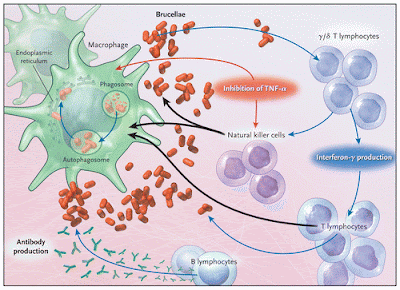Organisms like Brucella are detected in Cheese since from the Roman Era.Brucellosis(also known as Undulating fever or Mediterranean fever) was predominant in a Mediterranean region and its History is associated with Military campaigns.The disease caused by Brucella was fully Elucidated by Sir David Bruce,Hughes,and Zammit working In Malta.
Introduction:-
The disease remains the world’s most common Zoonotic disease with over half a million new cases annually and the Prevalence rate in some cases exceeds 10 cases per 1 lack population,being higher in people working in organized farms.Despite being endemic in developing countries Brucellosis is under diagnosed and under reported.
Commonly it Causes abortion in cattle and man but it is rarely fatal(it is reported that 2% of untreated patients died of brucellosis) and can lead to severe debilitation and disability in man.
The timely and accurate diagnosis is a great challenge for clinicians because of its non-specific clinical features(Headache,insomnia,anorexia,asthenia,night sweat), a slow growth rate in blood culture and its complexity in serodiagnosis.
Ø Maximum incidence of brucellosis is indicated in Syria but according to world health organization is (WHO) the real incidence is 10-25 more than it is reported.
Ø The most important factor in infection and transmission of brucellosis is Processing milk,Climate Condition,Hygienic environment,Economic and Social conditions.
Species:-
These are small intracellular,aerobic Occ bacilli localized in the reproductive system of host animal causing abortion and sterility.They are shed in large number in animal’s urine,milk,placental fluid and other secretory fluids.
Ø Total 10 species are recognized so far according to their pathogenicity.
Ø 4 species have moderate-to-significant human pathogenicity.
1. B.melitensis(from sheep ; highest pathogenicity)
2. B.suis(from pigs;high pathogenicity)
3. B.abortus(from cattle;moderate pathogenicity)
4. B.canis(from dogs;moderate pathogenicity)
Ø The brucella genome contain 2 circular chromosomes without plasmids suggesting a remarkable difference from bacteria with single chromosomes.
Ø B.melitensis, B.suis and B.abortus genetic sequences are completely studied.Thier genome sequence has provided tremendous information for understanding Brucella Pathogenecity.
Pathogenicity:-
Brucella is facultative bacteria which are present into cells and they are able to avoid killing mechanism .They Proliferate within macrophages.For a successful infection Brucella requires these four requirements.
Ø Adherence
Ø invasion
Ø Establishment
Ø Dissemination within the host
Ø Brucella contain peculiar Non-classical Lipopolysaccharide which is the major cause of its virulence
Lipopolysaccharide has 3 domains
Ø O-antigen
Ø Core oligosaccharide
Ø Lipid A
DIAGNOSIS:-
Diagnostic methods are primarily based on serology with smooth LPS chains producing greatest immunological response in host. The major diagnostic problem is due to the similarity of the O-antigenic side chain of LPS of Brucella and other organisms like Yersinia enterocolitica O : 9, Vibrio. Cholerae and E. coli 0 : 157.
In the diagnosis of bacterial infections blood culture is the gold standard including brucellosis, but this method is successful in only 40 – 70% of the cases. Faster culture times and higher sensitivity may provided by bone marrow culture. Bone marrow cultures may also be superior to blood culture when evaluating patients with previous antibiotic use. Pus after infection, infected tissues , cerebrospinal fluid (CSF) in CNS, and pleural / joint / ascitic fluid can also be used for culturing of Brucella .
However, the results have not yet been universally reproducible.
Serodiagnosis:-
If culture techniques are not available we rely on agglutination tests such as Rose Bengal Test and Complement Fixation Test.
Ø On molecular basis PCR(polymerase chain reaction) is used for its detection.
Conclusion:-
Interests shown towards brucellosis has benefitted developing countries like Pakistan.The DNA-DNA hybridization study shows a great similarity between all species of brucella.Brucella do not follow a common route of virulence a lot of development in this regard is to be required.Asbrucella is health threat to man and animal so its early diagnosis is very important.As it is misdiagnosed or overlooked so veterinarian in endemic and non-endemic region must be aware how to diagnose it.
DOWNLOAD HERE

written by:Vet Rumman Aslam
email:rummanaslam@gmail.com








No comments:
Post a Comment